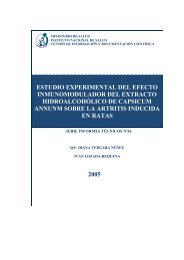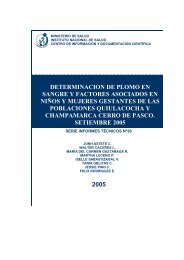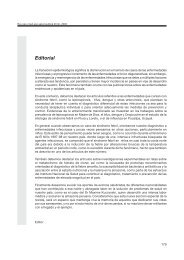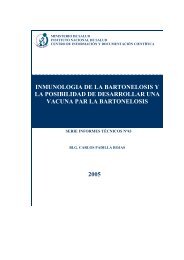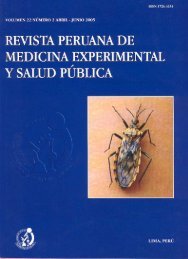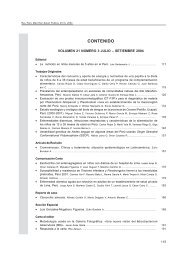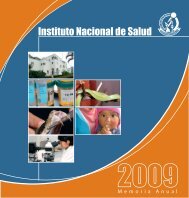rEVISta PErUaNa dE MEdIcINa ExPErIMENtaL y SaLUd PÃbLIca ...
rEVISta PErUaNa dE MEdIcINa ExPErIMENtaL y SaLUd PÃbLIca ...
rEVISta PErUaNa dE MEdIcINa ExPErIMENtaL y SaLUd PÃbLIca ...
You also want an ePaper? Increase the reach of your titles
YUMPU automatically turns print PDFs into web optimized ePapers that Google loves.
Rev Peru Med Exp Salud Publica. 2010; 27(1): 38-44.<br />
artículo original<br />
PREVALENCIA DEL INTENTO DE INTERRUMPIR EL<br />
EMBARAZO Y FACTORES ASOCIADOS EN UNA COMUNIDAD<br />
URBANO MARGINAL DE LIMA-PERÚ, 2006<br />
Carolina Tarqui-Mamani 1,2,a,c , Alejandro Barreda 3,b,d,e , Milagros Barreda 4,b,f ,<br />
Hernán Sanabria-Rojas 1,2,b,g,h<br />
RESUMEN<br />
Objetivos. Estimar la prevalencia y determinar los factores asociados al intento de interrumpir el embarazo en mujeres<br />
con antecedente de embarazo. Material y métodos. Se realizó un estudio transversal durante el año 2006. La muestra<br />
incluyó a 1057 mujeres con antecedente de embarazo que habitaban en Pamplona Alta, seleccionadas a través del<br />
muestreo probabilístico sistemático. Se realizó análisis estadístico descriptivo e inferencial, incluyendo un modelo de<br />
regresión logística. Resultados. La prevalencia de la intención de interrumpir su embarazo fue 13,9% (IC99%: 11,1-<br />
16,7). Al efectuarse un análisis multivariado, se encontró que los factores asociados fueron: embarazo no deseado<br />
(OR=5,7; IC: 1,9-16,7), la falta de atención prenatal (OR=4,7; IC: 1,8-12,2), la prostitución (OR=11,4; IC: 1,5-87,9),<br />
tener menos de 20 años (OR=2,9; IC: 1,1-7,9) y tener más de dos parejas (OR=3,3; IC: 1,1-10,2). Conclusiones. La<br />
prevalencia estimada del intento de interrumpir el embarazo en mujeres con antecedente de embarazo en una zona<br />
urbano marginal de Lima es baja si se compara al estimado nacional de abortos. Los factores asociados al intento de<br />
interrumpir el embarazo son: el embarazo no deseado, prostitución, tener menos de 20 años, tener más de dos parejas<br />
y la falta de atención prenatal.<br />
Palabras clave: Aborto; Interesados en Aborto; Embarazo no Deseado; Embarazo no Planeado; Epidemiología (fuente:<br />
DeCS BIREME).<br />
PREVALENCE OF THE ATTEMPTS TO STOP PREGNANCY AND<br />
ASSOCIATED FACTORS IN A MARGINAL SUBURBAN COMUNNITY IN<br />
LIMA-PERU, 2006<br />
ABSTRACT<br />
Objectives. To estimate the prevalence for the attempts to stop pregnancy among women with history of previous<br />
pregnancies, and to determine the factors associated. Material and methods. A cross-sectional study was performed<br />
during 2006. Samples included 1057 women with background of pregnancy, living in Pamplona Alta, selected by a<br />
systematic random sampling. We applied descriptive and inferential statistics, including a logistic regression model.<br />
Results. The prevalence for the attempt to stop pregnancy was 13.9% (99% CI: 11.1-16.7). The factors associated<br />
identified by multivariate analysis were: Unwanted pregnancy (OR=5.7; CI: 1.9-16.7), lack of pre-natal care (OR=4.7;<br />
CI: 1.8-12.2), prostitution (OR=11.4; CI: 1.5-87.9), age below 20 years (OR=2.9; CI: 1.1-7.9), and having more than two<br />
partners (OR=3.3; CI: 1.1-10.2). Conclusions. The estimated prevalence for the attempt to stop pregnancy among<br />
women with history of previous pregnancies in a marginal suburban area from Lima was low when compared to the<br />
national estimated prevalence of abortion. The associated factors identified for the attempts to stop pregnancy are:<br />
unwanted pregnancy, prostitution, age below 20 years, having more than two partners and lack of pre-natal care.<br />
Key words: Abortion; Abortion Applicants; Pregnancy, Unwanted; Pregnancy, Unplanned; Epidemiology (source: MeSH NLM).<br />
INTRODUCCIÓN<br />
Por lo general, el embarazo constituye un acontecimiento<br />
feliz para la familia y en especial para la mujer, sobre<br />
todo cuando ha sido planificado. Sin embargo, cuando el<br />
embarazo no fue deseado conlleva a enfrentar decisiones<br />
difíciles que pueden ser un riesgo para la salud. Cuando<br />
se presenta este tipo de situación se tiene dos opciones:<br />
por un lado, intentar su interrupción a través de un aborto<br />
inducido, con todos los riesgos y consecuencias que<br />
este procedimiento implica y por otro, continuar con el<br />
embarazo (1,2) . La interrupción voluntaria del embarazo<br />
1<br />
Instituto Nacional de Salud. Lima, Perú.<br />
2<br />
Departamento de Medicina Preventiva y Salud Pública, Facultad de Medicina, Universidad Nacional Mayor de San Marcos. Lima, Perú.<br />
3<br />
Departamento de Ginecología y Obstetricia, Facultad de Medicina, Universidad Nacional Mayor de San Marcos. Lima, Perú.<br />
4<br />
Centro de Salud Ollantay, Dirección de Salud Lima II, Ministerio de Salud. Lima, Perú<br />
a<br />
Obstetriz; b Médico Cirujano; c Magíster en epidemiología; d Especialista en Ginecología y Obstetricia; e Doctor en Medicina;<br />
f<br />
Magíster en Salud Reproductiva; g Especialista en Enfermedades Infecciosas y Tropicales; h Magíster en Medicina.<br />
Recibido: 03-02-10 Aprobado: 17-03-10<br />
38



